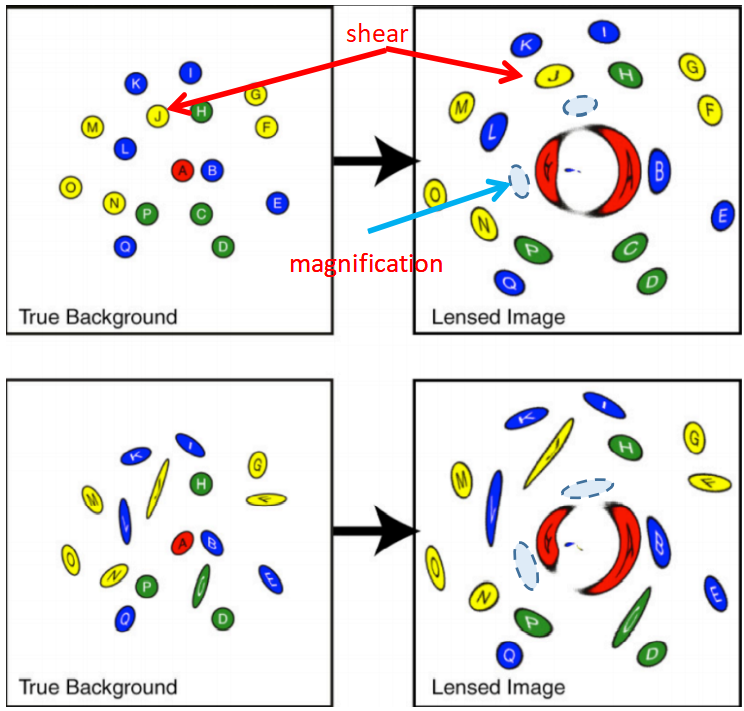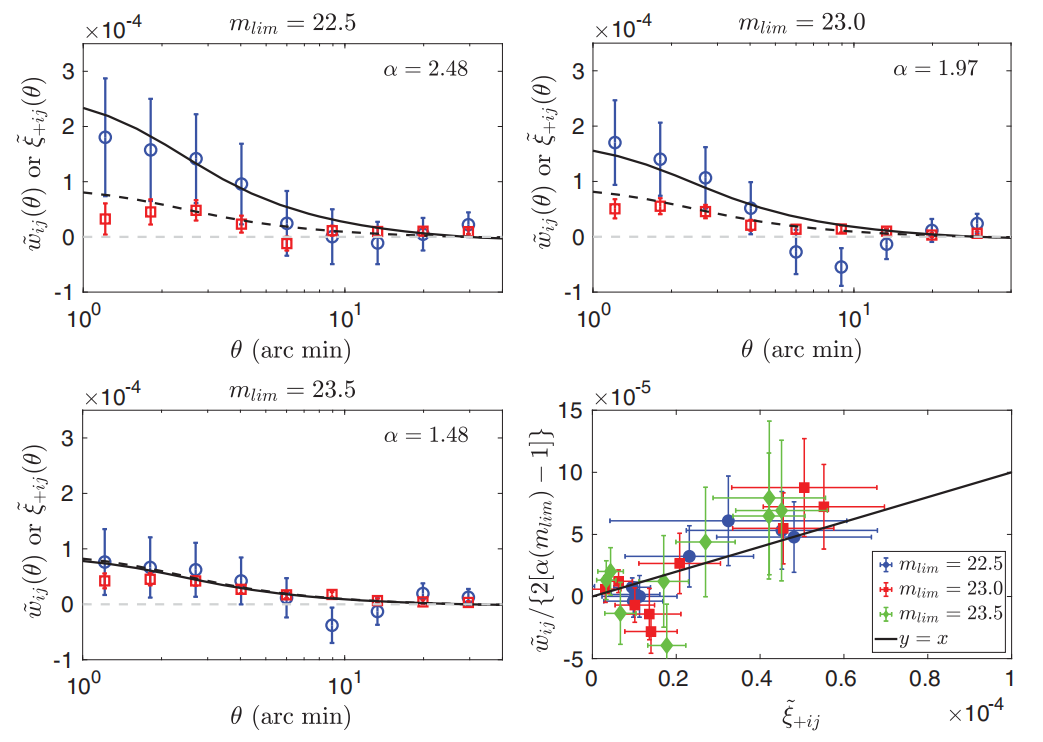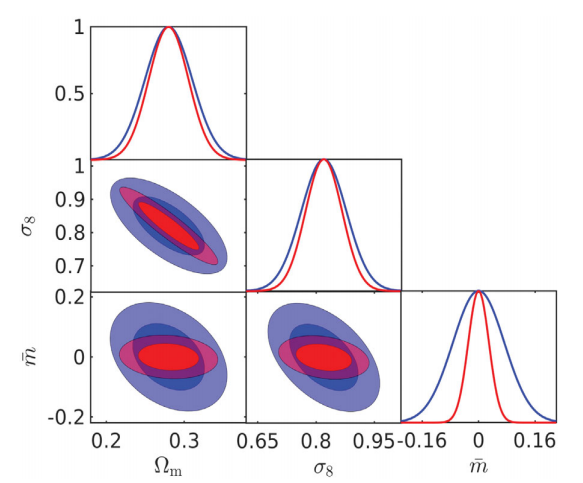中国西南天文研究所宇宙学团组基于HSC首次利用星系剪切-星系数密度互相关探测宇宙放大率信号
Detection of cosmic magnification via galaxy shear-galaxy number density
correlation from HSC survey data
近日,新利18体育新范祖辉教授带领的宇宙学团组提出一种探测宇宙引力透镜放大率的新方法—剪切-位置互相关分析法,并应用于日本昴星团望远镜主焦点相机巡天(HSC-SSP)数据,首次成功探测到由引力透镜放大率引起的剪切-位置互相关信号。进一步与剪切-剪切相关信号相结合,该方法可以有效地检验观测到的弱引力透镜剪切信号和放大率信号的自洽性,限制剪切信号的测量偏差。

图1. 剪切和放大效应示意图。Figure 1. Sketch of shear and magnification. (credit: astro.uchicago.edu)
弱引力透镜效应是研究暗物质暗能量和引力性质的独特的宇宙学探针,其观测效应体现在星系形状(剪切)和亮度(放大率)的微小改变,见图1。因其微弱性,准确测量弱引力透镜信号极具挑战性。当前的弱引力透镜宇宙学研究主要基于剪切信号的测量,而放大率信号的提取仍受限于星系内禀成团性和星系偏袒因子的影响。

图2. HSC-SSP观测数据的互相关分析结果。前三幅图中蓝色与红色分别为剪切-位置互相关以及剪切-剪切互相关结果。
Figure 2. Correlation results from HSC-SSP observational data. Blue and red symbols in the first 3 panels are the results of shear-number density correlations and shear-shear correlations, respectively.
在该工作中,该团组提出一种将前景星系剪切信号与背景星系位置做互相关分析的新方法,其所探测到宇宙放大率信号不受星系偏袒因子的影响。通过结合剪切-剪切两点相关,该方法还可以对观测数据本身进行重要的一致性检验,并对剪切测量偏置因子进行限制。图2为利用HSC-SSP数据测量到的剪切-位置互相关和剪切-剪切相关信号。可以看出,我们明确探测到了放大率引起的剪切-位置互相关,且其与剪切信号自洽,检验了HSC-SSP数据的可靠性。这是首次从观测数据中探测到剪切-位置相关信号。

图3. 15000平方度天区的Fisher预言。其中蓝、红色分别代表仅考虑剪切-剪切互相关以及联合考虑剪切-位置互相关后所得的限制结果。
Figure 3. Fisher forecast results with the survey area of 15000 deg2. Blue and red are, respectively, the results from shear-shear correlations only and from a combination of shear-shear and shear-number density correlations.
他们进一步分析了利用该方法限制剪切测量偏置因子从而提高宇宙学参数限制精度的能力。图3显示了针对未来15000 deg2巡天的预言结果,其中m为剪切测量乘性偏置因子,Ωm和 σ8为宇宙物质密度和涨落幅度参数。结果清晰地表明,加入剪切-位置互相关,可以有效地利用数据自身限制m,且不依赖于宇宙学参数。同时,与仅用剪切-剪切相关(蓝色)相比,宇宙学参数的限制能力有了显著提升(红色)。这充分展现了该方法在未来弱引力透镜宇宙学研究中的重要性。
该研究工作已在物理学及天文学权威国际学术期刊《物理评论D》(Physical Review D)发表(文章链接:https://journals.aps.org/prd/abstract/10.1103/PhysRevD.103.123504,预印本文库链接https://arxiv.org/pdf/2104.13595.pdf)。新利18体育新刘项琨副教授为文章第一作者, 刘德子博士为第二作者,刘项琨和范祖辉教授为共同通讯作者。合作作者包括SWIFAR访问学者Toshifumi Futamase,以及紫金山天文台、上海师范大学和北京大学合作者。

Recently, a team led by Prof. Zuhui Fan from SWIFAR, YNU, proposed a novel method to detect cosmic magnification signals by cross-correlating foreground convergence fields constructed from galaxy shear measurements with background galaxy positional distributions - namely, shear-number density correlation. We applied it to the Hyper Suprime-Cam Subaru Strategic Program (HSC-SSP) survey data, and for the first time successfully detected the shear-number density correlation signals. By combining with the shear-shear correlation, we further demonstrated the power of this new method in testing the consistence of the observed weak lensing signals, and in constraining the shear measurement bias using data themselves.
Arising from the gravitational light bending of cosmic large-scale structures, weak lensing effects are unique in probing the dark side of the Universe. Their observational signals show up as tiny shape distortions (shear) and magnitude changes (magnification) of far-away objects. Because of their weakness, it is extremely challenging to extract weak lensing signals observationally. The current weak lensing cosmological studies are primarily based on shear signal measurements. For the magnification signals, their extraction is still limited by the contamination of the galaxy intrinsic clustering and the galaxy bias.
In this study, they put forward a method to cross-correlate the foreground shear and background position of galaxies, which can extract cosmic magnification signals devoid of the impact of galaxy bias. It can further test the weak lensing data consistency in conjunction with the shear-shear correlations, and constrain the multiplicative bias of shear measurements. Figure 2 shows our results from HSC-SSP data analyses. We can see that, for the first time, the shear-position correlations are clearly detected observationally. Their consistency with the shear-shear correlations provides an important test of robustness of the HSC-SSP data.
They further explore the cosmological potential of combining the shear-position correlations with the commonly used shear-shear correlations. Figure 3 shows the forecast for a survey of 15000 deg2. By comparing with that using shear-shear correlations alone (blue), we can see clearly that the combined analyses (red) can constrain the shear multiplicative bias parameter m much more tightly, and eliminate the degeneracy between m and cosmological parameters. Consequently, the constraints on cosmological parameters are improved significantly. This analysis demonstrates fully the importance of including the shear-position correlations in future cosmological studies.
This paper has been published in Physical Review D (link: https://journals.aps.org/prd/abstract/10.1103/PhysRevD.103.123504, arXiv link: https://arxiv.org/abs/1709.07651). Xiangkun Liu from SWIFAR is the first author. Dezi Liu is the second author. Xiangkun Liu and and Zuhui Fan are the co-corresponding authors. The coauthors include SWIFAR visiting fellow Prof. Toshifumi Futamase and the collaborators from Purple Mountain Observatory, Shanghai Normal University and Peking University.
